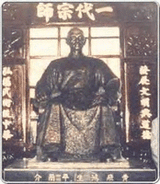Wong Fei Hung

Wong Fei Hung 1850- 1933
“The Godfather of Chinese Kung Fu”

Wong Fei Hung was a Kung Fu Grandmaster of the Chinese martial art Hung Gar. He was a philosopher, physician, and revolutionary people’s hero. He is considered one of the forefathers of modern day martial arts. The Shaolin Hung Gar style is one of the oldest arts of fighting in China. The style revolves around five animals; Tiger, Crane, Leopard, Snake and Dragon.
Wong Fei Hung was born in 1850 in Guangdong, Lam Hoi Province, Sai Chu County, Luk Huern Yan villiage, China. His father was Wong Kei Ying, a student and disciple of southern Siu Lum Master Luk Ah Choi. He was also one of the earlier Ten Canton Tigers of the late Ching Dynasty. While Wong Fei Hung was one of the later Tigers, both Wong Kei Ying and Wong Fei Hung were inducted into the Ten Tigers while they were in their early twenties. The other 8 Tigers were at an advanced age and of a higher kung fu generation. The positions of the "tigers" were chosen according to Chinese tradition, with the oldest or most senior given the highest position, a placement given out of respect, and nothing to do with level of skill. The induction showed great respect and honour for the Wongs. Their skills were compared with the Sifus (Kung Fu masters).
Wong Fei-Hung began his martial arts training at the age of five, with his father’s teacher, Luk Ah-Choy, who taught him the basics of Hung Gar. Later, Kay-Ying would take over his son’s training. By age 13 he was already an accomplished martial artist, and would often go out with his father to demonstrate Kung-Fu and sell medicine in different villages. On one occasion a famous teacher challenged Wong Kay-Ying because he felt the two were invading his territory. Kay-Ying accepted and said his 13-year old son would take up his pole and match skills with the sifu using the “Ng Long Ba Gwan Gwun” (8 diagram pole technique). Fei-Hung eliminated the challenger. Word soon spread far and wide.
Wong Fei Hung is credited with formalizing the orthodox Hung System and creating the style’s most famous set, the "Tiger Crane Double Pattern Fist Form" (Fu Hok Seung Ying Kuen), 18 methods of Hung Gar locking hand (Sup Baht Faht Cum Na Sao) and the 10 killing hands (Sup Juet Sao), which was only ever taught to certain disciples. At the end of the Ching dynasty and the founding of the republic in 1912, Fei-Hung became head instructor of martial arts, special forces elite military unit, under General Lau Wing Fuk in Canton.
In October 1924 there was a strike against the government by all the businesses. Canton city fell to riots and Wong Fei Hung's home and herbal shop were burnt to the ground. He lost all his belongings and money. Later on, his son Wong Hawn Sum was shot dead in an altercation with a drug gang. After this tragedy, Wong–Fei refused to teach martial arts to his other sons.
Fei-Hung died in his home at the age of 83, in 1933. There has been some ambitious storytelling by some films. Yet little was really known about this celebrated Kung-Fu master, philosopher, physician and people’s hero. What is known is that he has left an indelible mark upon Hong Kong cinema and the martial arts world.
